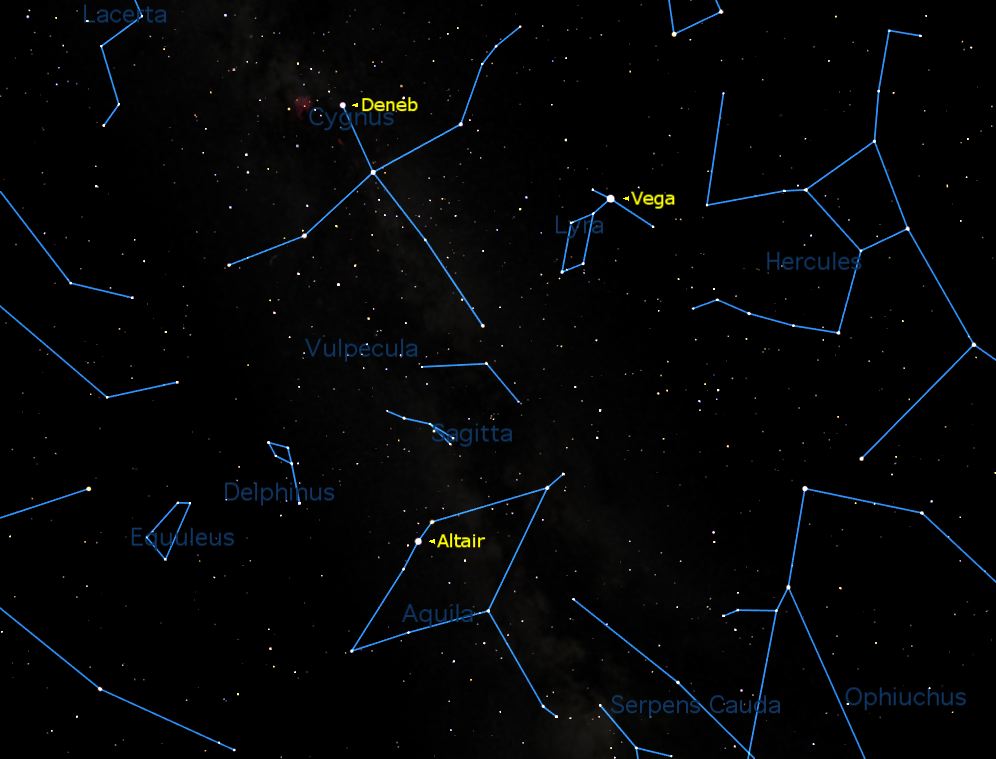Summer Triangle: Asterism of 3 Stars From 3 Constellations

The Summer Triangle is a Northern Hemisphere asterism (stars of similar brightness recognized in a distinctive shape). Unlike many other asterisms, the Summer Triangle is actually an amalgamation of stars from three separate constellations.
Three stars make up the triangle: Deneb, Vega and Altair. Deneb is the farthest away from Earth among these three, and is the brightest star in the constellation Cygnus; it forms the tail of the Swan. Coincidentally, Deneb is also the head of another asterism known as the Northern Cross, which is contained in Cygnus.
Vega is the brightest star of an otherwise dim and small constellation, Lyra (the Harp). Vega is one of the brightest stars in the night sky. (Sirius is the brightest in the night sky, but appears in the winter of the Northern Hemisphere.) About 12,000 years ago, it used to be the North Star due to an effect called precession, where the Earth's north-pointing direction changes due to a wobbling axis.
Rounding out the asterism is Altair, which is the brightest star in the constellation Aquilia (the Eagle.) Altair is one of the brightest close stars to Earth.
Asterism popularized in the 1950s
Unlike other asterisms such as the Big Dipper or the Little Dipper, the Summer Triangle is a recently popularized term.
The three stars have been recognized for some time as having similar brightness (although it should be noted that Deneb is about 1,400 light-years away while Vega and Altair are roughly 20 light-years away each, showing how much more luminous Deneb is.) [Related: Brightest Stars: Luminosity & Magnitude]
“It's appeared in various works for generations,” said Tom Kerss, an astronomer at the Royal Observatory Greenwich, in a Space.com interview. “Johann Bode traced the Summer Triangle in his star maps to the early 19th century, but it was unlabelled. It was then recognized as a way of navigating.”
Breaking space news, the latest updates on rocket launches, skywatching events and more!
A rough approximation of the term appears in works by Oswald Thomas, an Austrian astronomer, who referred to it as “Sommerliches Dreieck” (the Summerly Triangle) in the 1930s, Kerss added. Then in the 1950s, two astronomy popularizers picked up the term and made it generally known in the public: H.A. Rey in the United States and Patrick Moore in the United Kingdom.
Recent astronomical news
Vega was discovered to have an asteroid belt in 2013, leading astronomers to suggest that the star could host planets. Astronomers detected signs of icy asteroids in the outer regions of the star, and space rocks closer in. It was a similar signature to what was detected in another bright star in the sky, that of Fomalhaut.
"Overall, the large gap between the warm and the cold belts is a signpost that points to multiple planets likely orbiting around Vega and Fomalhaut," said Kate Su, an astronomer at the Steward Observatory at the University of Arizona, at the American Astronomical Society 2013 annual meeting.
Vega is also a fast rotater. In 2006, astronomers discovered it is whirling around so quickly — every 12.5 hours — that its equator is many thousand degrees cooler than its poles. If the star rotated just 10 percentage points faster, it would be at its critical rotation speed — the point at which the star would self-destruct due to its fast rotation. The star is sometimes cited in the literature as a comparison to the rotation of other stars, such as the slowly rotating KIC 11145123.
Altair also rotates fairly quickly and has flattening at its poles, which astronomers spotted in 2006 using long-baseline interferometery (which links together numerous telescopes to together look at a region of the sky.) In 2014, the XMM-Newton mission observed Altair, showing that the star has a corona (outer atmosphere) that changes depending on magnetic and rotational activity.
Deneb, meanwhile, is on astronomers' watchlist as a probable future supernova. Because the star is so bright, it is sometimes used as a testing platform for new professional telescopes, or for simulating the positions of objects in astronomical pictures.
Additional resources
- The Stars website, created by Jim Kaler, professor emeritus of astronomy at the University of Illinois, has more information about the Summer Triangle.
- NASA's "Astronomy Picture of the Day" features a beautiful image of the Summer Triangle over Catalonia.
- Astronomer David Darling's Encyclopedia of Science has an entry on the Summer Triangle.

Elizabeth Howell (she/her), Ph.D., was a staff writer in the spaceflight channel between 2022 and 2024 specializing in Canadian space news. She was contributing writer for Space.com for 10 years from 2012 to 2024. Elizabeth's reporting includes multiple exclusives with the White House, leading world coverage about a lost-and-found space tomato on the International Space Station, witnessing five human spaceflight launches on two continents, flying parabolic, working inside a spacesuit, and participating in a simulated Mars mission. Her latest book, "Why Am I Taller?" (ECW Press, 2022) is co-written with astronaut Dave Williams.

